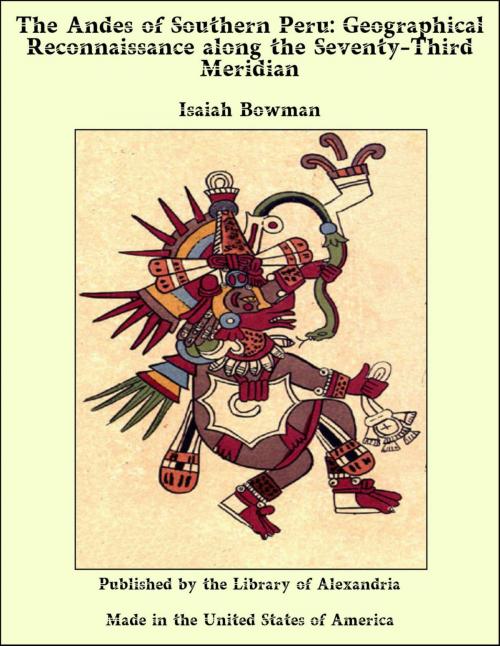The Andes of Southern Peru: Geographical Reconnaissance along the Seventy-Third Meridian
Nonfiction, Religion & Spirituality, New Age, History, Fiction & Literature| Author: | Isaiah Bowman | ISBN: | 9781465582058 |
| Publisher: | Library of Alexandria | Publication: | March 8, 2015 |
| Imprint: | Language: | English |
| Author: | Isaiah Bowman |
| ISBN: | 9781465582058 |
| Publisher: | Library of Alexandria |
| Publication: | March 8, 2015 |
| Imprint: | |
| Language: | English |
THE geographic work of the Yale Peruvian Expedition of 1911 was essentially a reconnaissance of the Peruvian Andes along the 73rd meridian. The route led from the tropical plains of the lower Urubamba southward over lofty snow-covered passes to the desert coast at Camaná. The strong climatic and topographic contrasts and the varied human life which the region contains are of geographic interest chiefly because they present so many and such clear cases of environmental control within short distances. Though we speak of “isolated” mountain communities in the Andes, it is only in a relative sense. The extreme isolation felt in some of the world’s great deserts is here unknown. It is therefore all the more remarkable when we come upon differences of customs and character in Peru to find them strongly developed in spite of the small distances that separate unlike groups of people. My division of the Expedition undertook to make a contour map of the two-hundred-mile stretch of mountain country between Abancay and the Pacific coast, and a great deal of detailed geographic and physiographic work had to be sacrificed to insure the completion of the survey. Camp sites, forage, water, and, above all, strong beasts for the topographer’s difficult and excessively lofty stations brought daily problems that were always serious and sometimes critical. I was so deeply interested in the progress of the topographic map that whenever it came to a choice of plans the map and not the geography was first considered. The effect upon my work was to distribute it with little regard to the demands of the problems, but I cannot regret this in view of the great value of the maps. Mr. Kai Hendriksen did splendid work in putting through two hundred miles of plane-tabling in two months under conditions of extreme difficulty. Many of his triangulation stations ranged in elevation from 14,000 to nearly 18,000 feet, and the cold and storms—especially the hailstorms of mid-afternoon—were at times most severe.
THE geographic work of the Yale Peruvian Expedition of 1911 was essentially a reconnaissance of the Peruvian Andes along the 73rd meridian. The route led from the tropical plains of the lower Urubamba southward over lofty snow-covered passes to the desert coast at Camaná. The strong climatic and topographic contrasts and the varied human life which the region contains are of geographic interest chiefly because they present so many and such clear cases of environmental control within short distances. Though we speak of “isolated” mountain communities in the Andes, it is only in a relative sense. The extreme isolation felt in some of the world’s great deserts is here unknown. It is therefore all the more remarkable when we come upon differences of customs and character in Peru to find them strongly developed in spite of the small distances that separate unlike groups of people. My division of the Expedition undertook to make a contour map of the two-hundred-mile stretch of mountain country between Abancay and the Pacific coast, and a great deal of detailed geographic and physiographic work had to be sacrificed to insure the completion of the survey. Camp sites, forage, water, and, above all, strong beasts for the topographer’s difficult and excessively lofty stations brought daily problems that were always serious and sometimes critical. I was so deeply interested in the progress of the topographic map that whenever it came to a choice of plans the map and not the geography was first considered. The effect upon my work was to distribute it with little regard to the demands of the problems, but I cannot regret this in view of the great value of the maps. Mr. Kai Hendriksen did splendid work in putting through two hundred miles of plane-tabling in two months under conditions of extreme difficulty. Many of his triangulation stations ranged in elevation from 14,000 to nearly 18,000 feet, and the cold and storms—especially the hailstorms of mid-afternoon—were at times most severe.















